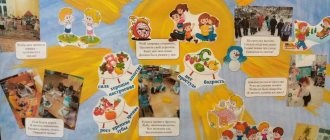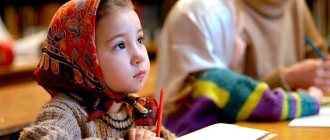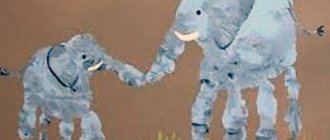Individualization technologies in the educational process of preschool educational institutions
Municipal autonomous preschool educational institution General developmental kindergarten No. 77 in Tomsk
Individualization technologies in the educational process of preschool educational institutions
(pedagogical piggy bank from work experience)
Zharkova M.A.,
teacher speech therapist
MADOU No. 77
Personalization
- this is the development of characteristics that distinguish a person from the surrounding mass.
In the general provisions of the Federal State Educational Standard in paragraph 1.4. — the basic principles aimed at developing the individualization of preschool education are revealed:
-building educational activities based on the individual characteristics of each child, in which the child himself becomes active in choosing the content of his education, becomes a subject of education (hereinafter referred to as individualization of preschool education)
-supporting children's initiative in various activities
- age adequacy of preschool education (compliance of conditions, requirements, methods with age and developmental characteristics).
Teacher's goal:
creating conditions for the individualization of educational relations, ensuring the possibility of social self-determination of the child, independence and initiative.
Teacher's tasks:
- to form in children adequate ideas about the relationships in the “man-environment” system and in the surrounding world itself, based on universal human principles;
-individualization of education for each child;
- to form in the child a value-based attitude towards the world around him, which determines the nature of the goals of interaction with him, motives, readiness to choose certain strategies of behavior from the point of view of moral expediency and his understandings and acceptances;
-to form a system of skills (technologies) and strategies for value-based interaction with the world;
-stimulate creative expression of oneself to the world and knowledge of the world through creative ways of mastering the surrounding reality in specific types of children's activities;
- create conditions for the child to develop independence in planning and implementing his plans;
- timely identify, support and develop children’s abilities and children’s interests;
-formation and development of personality traits in preschoolers, providing the opportunity for the child’s social self-determination, independence and initiative;
- create conditions for the development of independence in planning and implementation of plans;
-develop a teaching staff system for individual child support;
- to develop the activity of a preschooler in various types of children's activities under the conditions of socialization and individualization of children.
Conditions for individualization:
1) ensuring emotional well-being through: direct communication with each child; respectful attitude towards each child, his feelings and needs;
2) supporting the individuality and initiative of children through: creating conditions for the child’s free choice of activities, participants in joint activities; creating conditions for the child to make decisions, express his feelings and thoughts; non-directive assistance to children, support for children's initiative and independence in various types of activities (play, research, design, cognitive, etc.);
3) establishing rules of interaction in different situations: creating conditions for positive, friendly relationships between children, including those belonging to different national, cultural, religious communities and social strata, as well as those who have different (including limited) health capabilities; development of children’s communication abilities, allowing them to resolve conflict situations with peers; developing children’s ability to work in a peer group;
4) construction of variable developmental education, focused on the level of development that is manifested in the child in joint activities with adults and more experienced peers, but is not actualized in his individual activities (hereinafter referred to as the zone of proximal development of each child, through: creating conditions for mastering cultural means of activity ; organization of activities that promote the development of thinking, speech, communication, imagination and children's creativity, personal, physical and artistic-aesthetic development of children; support for children's spontaneous play, its enrichment, provision of play time and space; assessment of children's individual development;
5) interaction with parents (legal representatives) on issues of the child’s education, their direct involvement in educational activities, including through the creation of educational projects together with the family based on identifying needs and supporting the family’s educational initiatives.
The teacher needs to expand the necessary knowledge in children, update their personal experience, create a positive emotional mood, and encourage them to engage in purposeful, useful employment.
Mechanisms for the teacher to organize the individualization of children:
1. Mechanisms (mandatory requirements):
-diagnosis of the child’s abilities and inclinations;
-drawing a trajectory of a child’s success through creating a situation of choice and a situation of success:
• purposeful use of the trial and error method;
• expanding the range of materials and methods of activity;
• taking into account the principles of development of the child as a subject of his own activities (planning techniques);
-algorithms for the sequence of actions:
• creation of pedagogical conditions for the development of strong-willed qualities - the desire to complete a task by a child;
• determination of technology to assist and support the development of a child:
• a) methods; b) funds; c) free and regulated forms of interaction (communication and activity).
2. Specially organized activities in circles,
3. Special educational situations.
4. Free activity of children of a creative and productive nature,
5. Joint cognitive activity of subjects in the “adult-teacher-child” system and the corresponding subsystems “teacher-child (children)”, “teacher-child-parent”, “child-child (children)”.
Results of child individualization:
1. Diagnostics of the trajectory of success
2. Children's portfolio
3. Children's projects
4. Parent-child projects
5. Presentation of children's activity products.
An individual portfolio was presented at preschool educational institution No. 82
child, which is formed for 3 years. Starting from the middle group. The portfolio of each group differs in its content, but the structure is the same for the entire kindergarten: family tree, my surroundings, an individual educational route for 1 academic year, the child’s interests, favorite games, holidays, the happiest day. My horror stories, wishes and dreams for the future, child’s awards (certificates). The portfolio itself is filled out once a week in a group or at home. All pages are offered to children in black and white, the pictures are generalized, and children are invited to color them at their own discretion and desire. In this preschool educational institution, a group portfolio is also maintained, which is filled out by teachers together with the children, the achievements of the entire group.
Individualization of the process in preschool educational institution No. 82 is implemented through success corners.
These corners help to evaluate each child objectively and subjectively, both for the teacher and for the child. Success corners are designed in each group at the discretion of the teachers. The corner itself is a screen with pockets, above each pocket there is a photo or the name of the child. A card lined into 5 parts according to the days of the week is inserted into the pocket. Each color of the week is designated by a specific color. The Success Corner is filled daily in the afternoon. In the middle group, the corner is filled out together with the teacher, and in the senior and preparatory groups, children fill it out independently. The child’s success is assessed by types of activities, which are depicted schematically or in the form of a picture. The child chooses a picture with the activity in which he considers himself successful during the day and sticks the picture on the card. In this way, the teacher can monitor the activities that the child is engaged in and, if necessary, offer other activities so that the child develops comprehensively. At the end of the month, the teacher fills out a summary table, which shows what the child likes and what he was interested in. Recommendations are given to parents on the development of the child.
Thus, the child in the group develops along his own individual path and teachers can easily track the interests and difficulties of the child.
Personalization is...
An individual approach in teaching practice involves focusing on the characteristics of the student and taking them into account when constructing the educational process. Working with the group as a whole, the teacher uses different schemes of cooperation with each member.
Individualization of learning is based on the choice of such forms, pace and directions of work that correspond to the characteristics of the students. This requires professional pedagogical diagnostics of the child’s personal characteristics when designing educational programs.
This formulation of the problem allows us to answer the question why individualization of learning is called a penetrating technology. The principle of an individual approach can be used in any technique. For example, this could be a project form, a game form, or a problem form.
Differentiation of learning and development in kindergarten
The variability of the modern preschool education system is harmoniously combined with the technologies of individualization and differentiation of education in preschool educational institutions. This is reflected in the principles of forming the group’s developmental environment and the methods of interaction between an adult and a child. The layout, equipment, and filling of groups with play materials are aimed at the individual development of children.
The child can choose one of several thematic zones (story play, speech development, experimentation), objects and materials, and determine with whom he wants to perform certain actions. The teacher’s task is to offer children types of activities that present a certain cognitive challenge. The teacher does not directly indicate what needs to be done, but leads the children to express their own ideas, taking into account their individual characteristics. An effective technique in this case is to rely on the potential of children with a higher level of cognitive and creative abilities, who can help others.
Individual form of organizing work in lessons
There are special requirements for a lesson in a modern school. The use of technologies to individualize learning is one of them. In this case, each student or group of students of the same level receives individual tasks that differ in the degree of complexity and creativity. The time it takes to complete a single task for the entire class may also vary.
Such forms of work require a change in the position of the teacher, who needs to differentiate the level of assistance provided to students from different groups.
Ideally, a student, having received a case to complete, independently determines the sequence of actions, the pace of work, and evaluates the result obtained. But for low-performing students, teacher support and the availability of action algorithms are important.
Technology of level differentiation and individualization of training
This technology assumes that the student does not learn the entire volume of program material, but as much as his capabilities allow, but not less than the minimum acceptable level. This step-by-step differentiation presupposes the presence of several options for programs in the subject, which will differ in volume and level of complexity. This technology of individualization of training and development allows:
- increase motivation within groups;
- eliminate the principle of “averaging” students;
- create comfortable conditions for educational work;
- provide a person-centered approach.
Differentiation can be based on the principle of dividing educational institutions (general education school, correctional school, gymnasium), creating different levels within institutions (strain, profile, compensatory education class) and classes (multi-age groups, electives).
Formation of an individual educational route
Technologies for individualizing learning are reflected in the school’s main educational program and curriculum, which provides for the so-called “student component.” We are talking about selecting the content of learning, the pace, and methods of assessing results, which add up to the student’s special individual educational trajectory. The construction of such a trajectory occurs according to the following algorithm:
- Carrying out diagnostics of a student’s personal capabilities, recording the current amount of knowledge and skills in a certain subject area.
- Determining the fundamental components of the topic being studied.
- Fixation of priority sections and their connection with the student’s interests.
- Formation of an individual program for studying selected objects.
- Implementation of the planned plan, independent assessment of the work performed.
- Presentation of the results obtained, collective discussion.
- Analysis, reflection.
System of individual lessons
The technology of individualization of learning involves the creation of certain algorithms for compiling programs, which are provided to the student as a kind of sample, which he can supplement and rework. As a result, the educational process is built on the basis of individual curricula. Most often, this approach is used in high schools to avoid overloading students.
Individual plans contribute to the professional orientation of students and allow taking into account the interests of all participants in the educational process.
An educational institution determines a set of courses and academic subjects available for mastering, then a curriculum and schedule are formed. As a result, students in the same class study disciplines at different levels and in different forms.
The implementation of individual plans should be preceded by a detailed analysis of the personnel, material, and content conditions of the educational environment of the organization, as well as the abilities and psychological characteristics of secondary school graduates.






